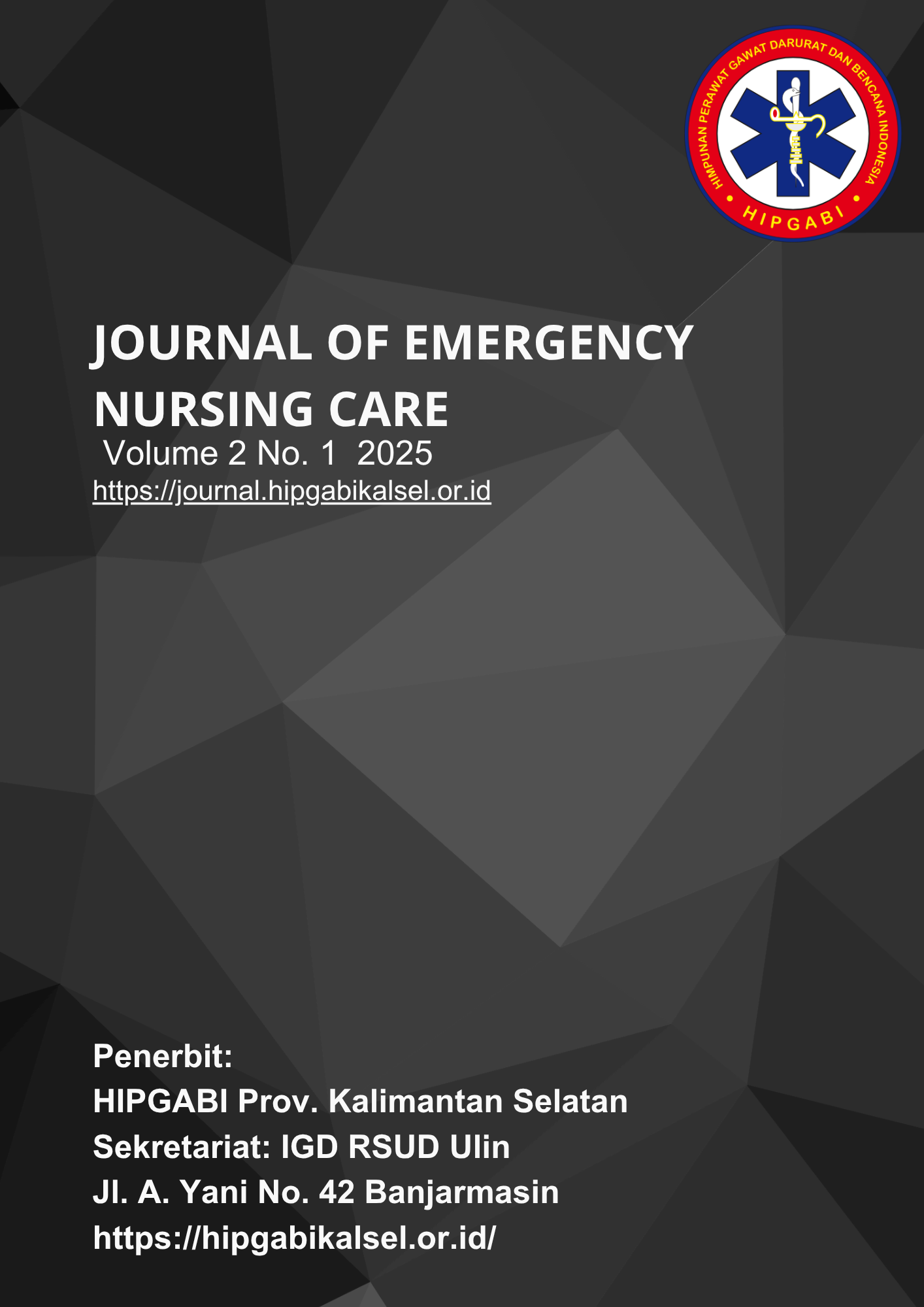ANALISIS SKOR NIHSS SEBAGAI PREDIKTOR KEJADIAN DELIRIUM PADA PASIEN STROKE
Keywords:
NIHSS, Delirium, StrokeAbstract
Latar Belakang: Secara global, stroke menjadi penyebab utama kecacatan. Banyak praktisi menganggap delirium adalah hal yang biasa terjadi pada pasien stroke, namun delirium merupakan kelainan serius yang berhubungan dengan pemanjangan lama rawat di ruang rawat intensif, perlambatan pemulihan fungsional, meningkatkan angka mortalitas dan morbilitas sampai 10 kali lipat.
Tujuan: Penelitian ini bertujuan untuk mengetahui hubungan tingkat keparahan dengan kejadian delirium pada pasien stroke.
Metode: Penelitian ini merupakan penelitian korelasi observasional dengan pendekatan cross sectional. Pengambilan sampel dengan tekhnik purposive sampling, berjumlah 52 responden. Pengumpulan data menggunakan lembar observasi NIHSS dan CAM-ICU dengan uji statistik Spearman Rank.
Hasil: Hasil uji statistik menunjukan p value = 0,000 < 0,05 dan dapat dinyatakan secara uji statistik terdapat hubungan yang signifikan antara output NIHSS dengan kejadian delirium pada pasien stroke.
Kesimpulan: Hubungan kedua variabel ini menunjukan kearah korelasi positif yang menunjukan bahwa hubungan kedua variabel memiliki hubungan sangat kuat.
References
Benjamin, E. J., Muntner, P., Alonso, A., Bittencourt, M. S., Callaway, C. W., Carson, A. P., ... & American Heart Association Council on Epidemiology and Prevention Statistics Committee and Stroke Statistics Subcommittee. (2019). Heart disease and stroke statistics—2019 update: a report from the American Heart Association. Circulation, 139(10), e56–e528.
Donkor, E. S. (2018). Stroke in the 21st century: A snapshot of the burden, epidemiology, and quality of life. Stroke Research and Treatment, 2018, 3238165.
Faught, E. (2014). Delirium and acute confusional states. In Encyclopedia of the Neurological Sciences (pp. 1164–1167). Elsevier.
Feigin, V. L., Norrving, B., & Mensah, G. A. (2016). Global burden of stroke. Circulation Research, 120(3), 439–448.
Feigin, V. L., Roth, G. A., Naghavi, M., & Parmar, P. (2018). Global burden of stroke and risk factors in 195 countries and territories, 1990–2017: A systematic analysis for the Global Burden of Disease Study 2017. The Lancet Neurology, 18(5), 439–458.
Global Burden of Disease Study. (2020). Global, regional, and national burden of stroke and its risk factors, 1990–2019: A systematic analysis for the Global Burden of Disease Study 2019. The Lancet Neurology, 20(10), 795–820.
Hakiki, S. N., Kosasih, C. E., Setyawati, A., Keperawatan, M. F., Padjadjarran, U., Kritis, D. K., … Stroke, P. (2021). Studi Literatur : Scoping Review Gambaran Faktor Dalam Prehospital Delay Pada Pasien Stroke A Literature Study : An Illustration Factors. 5(2), 656–671.
Harkitasari, S., Nuartha, A. A. B. N. & Purwata, T. E. (2015). Penurunan Jumlah Leukosit Sebagai Prediktor Perbaikan Klinis Penderita Stroke Hemoragik Selama Perawatan. Jurnal Ilmiah Kedokteran, 46(2): 92-98.
Hofen-Hohloch, J., Niesen, W. D., Tadic, V., Nolte, C. H., Poli, S., Huttner, H. B., & Nagel, S. (2020). Delirium Screening in Neurocritical Care and Stroke Unit Patients: A Pilot Study on the Infuence of Neurological Defcits on CAM-ICU and ICDSC Outcome. Neurocrit Care, 33: 708-717.
Irsyam, M., Dewi, D. R. L. & Ilmiawan, M. I. (2022). Hubungan Antara National Institute Of Health Stroke Score (Nihss) Dan Letak Lesi Pada Pasien Stroke Infark Di Rumah Sakit Umum Daerah Dr. Soedarso Pontianak. Jurnal Impresi Indonesia (JII), 1(4): 397-404.
Kasner, S. E. (2006). Clinical interpretation and use of stroke scales. The Lancet Neurology, 5(7), 603–612.
Kwah, L. K., & Diong, J. (2014). National Institutes of Health Stroke Scale (NIHSS). Journal of Physiotherapy, 60(1), 61.
Leonard, M., & Rahaman, N. (2017). Delirium detection and management in acute stroke: A scoping review. Age and Ageing, 46(5), 737–743.
Lindley, R. I. (2017). Stroke Seconde Edition. Oxford University Press.
Luman, A. (2015). Sindrom Delirium. Departement Ilmu Penyakit Dalam. Fakultas Kedokteran Universitas Sumatera Utara, Medan. (42).10, pp. 744-748
Maharani, D. P., Juli, F., & Nugraha, R. (2021). Stroke hemoragik dan faktor prognosisnya pada pasien di rumah sakit rujukan nasional. Jurnal Kesehatan Otak, 8(3), 120-133.
Nydahl, P., Bartoszek, G., Mende, H., & Needham, D. M. (2017). Delirium in the intensive care unit: A systematic review of risk factors. Critical Care Medicine, 45(2), 278–285.
Ovbiagele, B., & Turan, T. N. (2016). Stroke prevention and management strategies. Stroke, 47(12), e313–e314.
WHO. (2016). Global report on stroke prevention and control. World Health Organization.
Rahayu, N. P., Suryanto, T., & Widodo, A. (2018). Hubungan Mean Arterial Blood Pressure Dengan Keluaran Pasien Stroke Trombotik Yang Dinilai Dengan Skor NIHSS. Majalah Kesehatan, 5(3): 160-170.
Razdiq, Z. M. & Imran, Y. (2020). Hubungan antara tekanan darah dengan keparahan stroke menggunakan National Institute Health Stroke Scale. Jurnal Biomedika dan Kesehatan, 3(1): 15-20.
Wulan, D. R., & Erlida, B. A. (2020). The effect of NIHSS clinical score output toward delirium incident on stroke patient. Journal of Nursing Invention, 1(1).



